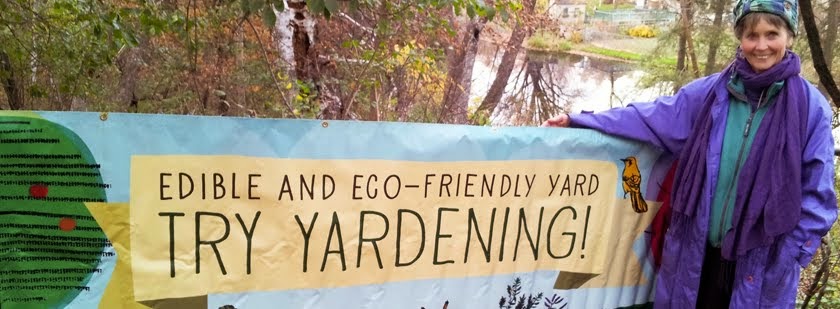Margaret Gerhard sprouted her gardening roots as a country girl of 12 working on a truck farm picking radishes for five cents per dozen, bushels of cucumbers and baskets of strawberries. She thickened her branches as a Franciscan nun, learning about and to care for the environment (also how to recycle and be frugal). And she became a yardener in Green Bay’s Schmidt Park while learning how to interplant herbs and flowers.
“If you plant mint around the outside of your house, it keeps the little rodents away,” Gerhard said. “I keep oregano, Egyptian onion, catnip, rhubarb, sorrel, chives, basil, lemon balm in my gardens, along with such plants as lettuce, beets, tomatoes, kale and natives like Jerusalem artichoke (Helianthus tuberosus L.) and woodland sunflowers (Helianthus strumosus). I tell everybody to plant more flowers. Lawns are boring. Boring, boring, BORING!”
The former middle school art teacher and nature center pioneer broke ground on her first exploration to eliminating her Schmidt Park lawn after seeing an Asplundh tree-trimming truck full of wood chips in her neighborhood. She asked about the chips, and a few days later had a load 12 feet high and 20 feet wide piled onto her front yard. A few hours of spreading and a couple good rainstorms later, and Gerhard’s grass was as good as dead and she had a hearty layer of uniform organic matter to provide a starting medium for planting.
“I tell people to go to a liquor store, buy a bottle and while you’re there, ask for cardboard boxes,” Gerhard said, explaining her inexpensive means for acquiring the necessary supplies for a technique frequently referred to as “lasagna gardening.”
Thankfully, she said, she had receptive neighbors during a time when lawns were (and in many areas are) viewed as a status symbol. Confirmation of her yardening brilliance was confirmed one drought-ridden summer.
“A couple of my neighbors pulled up in their car while I was out working in my front yard,” Gerhard said, eyes twinkling. “The electric motor of their powered window buzzed, and they said to me, ‘Margaret, look around! Your yard is the only one that’s green.’ All my neighbors lawns were dead brown, and my plants and flowers were flourishing.”
Gerhard supports her aversion to yards of turf with this fact: the exhaust output from one hour of gas-powered mowing is equal to driving 340 miles in a car. Replacing turf with a mix of area-friendly perennial flowers and annual vegetables saves people money on pesticides, herbicides and fertilizers. Gerhard scoffs at the excuse that gardening is a lot of work.
“Gardening is not any more work than going to the gym and working out,” she said. “I enjoy the workout of digging in the dirt and the labor of harvesting. The most labor-intensive part of gardening is in the fall with canning, and drying herbs. But the wonderful trade-off is homemade chili or sauces in the winter.”
“Gardening is not
any more work than
going to the gym
and working out.”
− Margaret Gerhard
any more work than
going to the gym
and working out.”
− Margaret Gerhard
Not a canner? Gerhard suggests using what produce you can consume and donating the remainder to food pantries, neighbors or bringing excess to work. Floral bouquets also make very inexpensive impromptu gifts for friends. Harvesting and saving seeds means saving even more money and time shopping for seeds and plants proven to grow in your yard.
The roots of perennial plants grow inches to feet deeper than turf grass, creating natural filtration, aeration and soil anchoring. Gerhard referenced the landscaping of street medians with native plants in the Milwaukee suburb of Brookfield. She believes has helped friends of hers reduce or eliminate the number of times each year they must pump sewage out of their basement during rain storms.
To receive the full benefit, and for safety’s sake, Gerhard recommends yardeners take classes on the medicinal uses of the plants they grow. Sweet Willow Naturals in Bellevue, The Herb Shop in De Pere, Aurora’s Apothecary Herb Shop in Morrison and The Healthy Way in Sturgeon Bay are retail venues for shopping and learning about the medicinal uses of plants and finding medicinal plants for what ails you. The beauty of a garden is very much in the eye of the beholder: some enjoy clean-cut perfection while others’ philosophy leans toward “go wild.” Regardless of your preference, Gerhard believes grass turf can and should be replaced to the benefit of the environment and finances. Who wouldn’t want to spend less money and time on their yard?
“We need to change our idea of what is beautiful.”.
About Paige Funkhouser
Paige lives in Door County year round. She is a national and state award-winning news reporter, a Door County Master Gardener, and partakes of all things edible. View all posts by Paige Funkhouser




